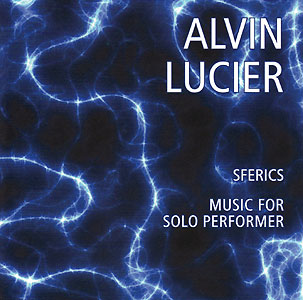
 |
|
 |
Format: CD Label & Cat.Number: Lovely Music LCD 5013 Release Year: 2009 Note: SFERICS (1981): recording of radio-frequency emissions in the ionosphere; MUSIC FOR SOLO PERFORMER (1965): new version of this piece using LUCIERS alpha-brainwaves as activator for different percussion instruments; two great concept to make the "Unlistenable" listenable, with curious results !
Price (incl. 19% VAT): €14.00 Warning: Currently we do not have this album in stock!
More Info"Sferics is the shortened term for atmospherics, natural radio-frequency emissions in the ionosphere, caused by electromagnetic energy radiated from nearby or distant lightning. These signals -- resonant clicks and pops, called tweeks and bonks by scientists -- occur in the audible range of humans and may be picked up by antennas and amplified for listening. They are best received at night, far from power lines. Occasionally, certain sferics get caught on and travel long distances along the magnetic flux lines around the earth, producing whistlers -- downward-gliding signals which may last up to two or three seconds. My interest in sferics goes back to 1967, when I discovered in the Brandeis University Library a disc recording of ionospheric sounds by astrophysicist Millett Morgan of Dartmouth College. I experimented with this material, processing it in various ways -- filtering, narrow band amplifying and phase-shifting -- but I was unhappy with the idea of altering natural sounds and uneasy about using someone else's material for my own purposes. I wanted to have the experience of listening to these sounds in real time and collecting them for myself. When Pauline Oliveros invited me to visit the music department at the University of California at San Diego a year later, I proposed a whistler recording project. Despite two weeks of extending antenna wire across most of the La Jolla landscape and wrestling with homemade battery-operated radio receivers, Pauline and I had nothing to show for our efforts. About ten years later composer Ned Sublette, who was interested in radio waves of all kinds, recommended a book by Calvin R. Graf, Listen to Radio Energy, Light and Sound, which describe a simple method of building a large loop antenna with which to receive these natural phenomena. Sferics was recorded by the composer on August 27, 1981, in Church Park, Colorado. The sound material was collected continuously from midnight to dawn with a pair of homemade antennas and a stereo cassette tape recorder. At regular intervals the antennas were repositioned in order to explore the directivity of the propagated signals and to shift the stereo field.""Music For Solo Performer was first performed on May 5, 1965 at the Rose Art Museum, Brandeis University, with the encouragement and participation of John Cage. I sat on a landing between the two floors of the museum, electrodes attached to my scalp. The mono output of the alpha amplifiers was routed to the inputs of 8 home stereo amplifiers, the outputs of which were sent to 16 loudspeaker-percussion pairs deployed around the museum. During the course of the 40-minute performance Cage randomly raised and lowered the stereo amplifiers' volume controls channeling the alpha signal to various instruments around the room. In 1982 two versions of Music For Solo Performer were released on Lovely Music LP VR 1014. On Side A the composer superimposed eight pairs of western classical percussion instruments, as well as a cardboard box and a metal trash can. On Side B Pauline Oliveros recorded four versions, each with a separate world music percussion orchestra. For that version composer Nicolas Collins designed a number of voltage-controlled solenoids that were used as electric drumsticks to play various small drums and gongs. This recording of Music For Solo Performer was produced under the supervision of Wesleyan professor of music Ron Kuivila with the assistance of graduate students Ivan Naranjo and Phillip Schulze and undergraduate Forrest Leslie, at the Wesleyan University Experimental Music Studio, on December 8 and 9, 2007." [from the credits] www.lovely.com |
| © 2007 Drone Records | | Celler Strasse 33, 28205 Bremen, Germany | Privacy and cookies policy | Impressum / Allgemeine Geschaftsbedingungen / Haftungsausschluss | Links to the scene |